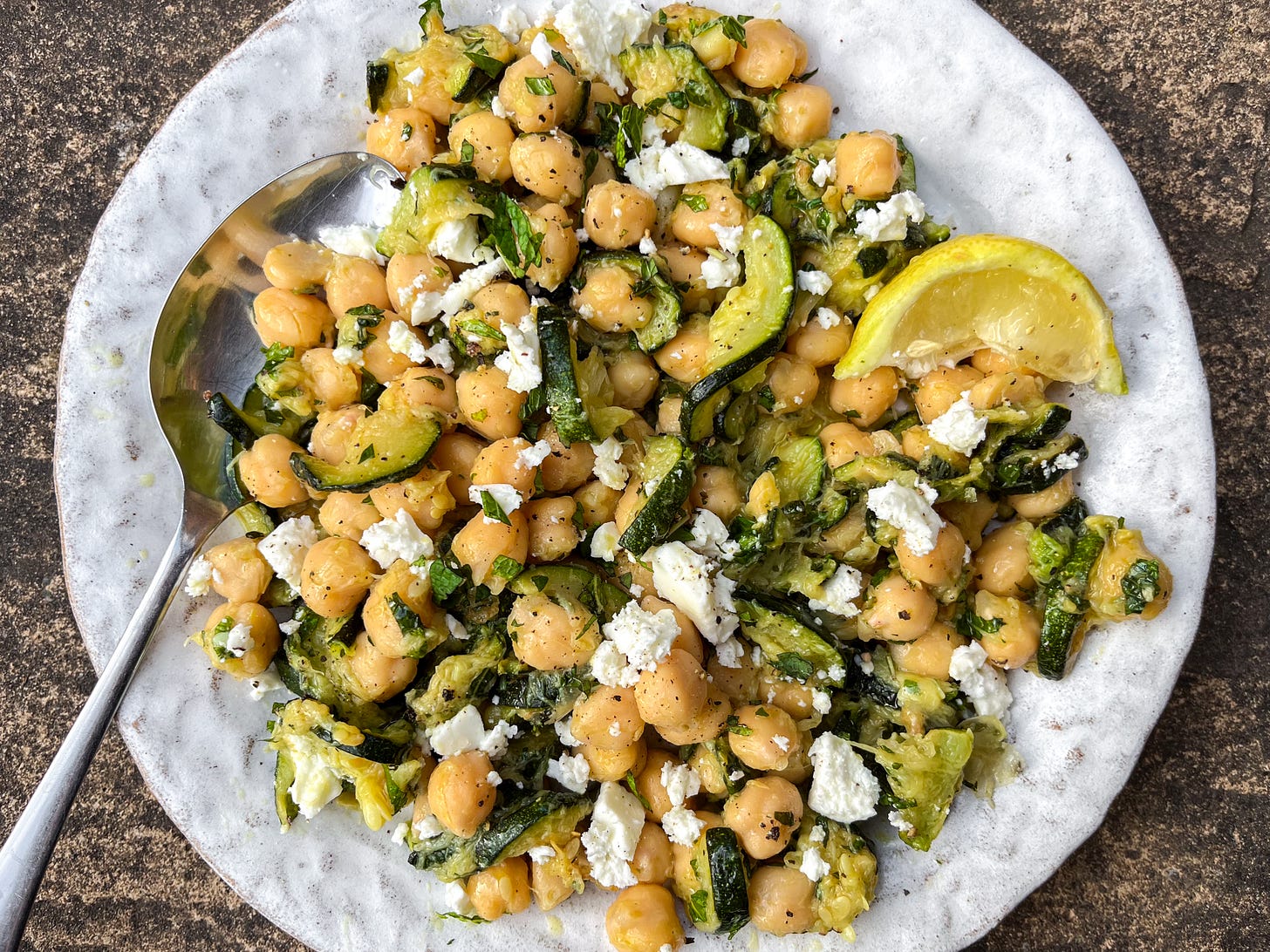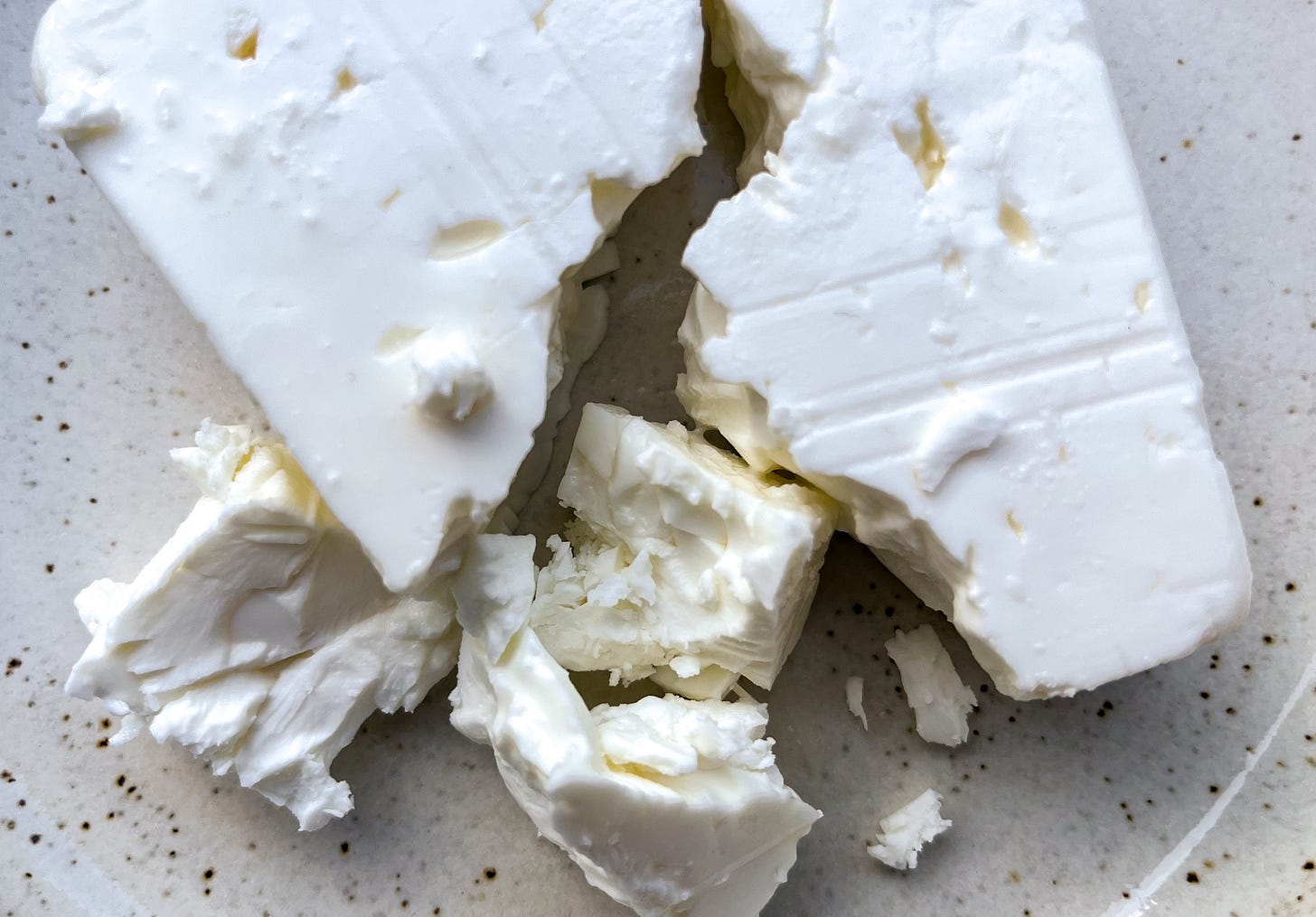Feta.
The perfect cheese for summer. Plus, my recipe for a Melting Courgette and Chickpea Salad.
Welcome to ingredient, where once a month I take a deep dive into some of my favourite seasonal and store cupboard ingredients. This month I’m focusing on Feta: the tangy, salty, crumbly Greek cheese that adds a kiss of salty creaminess to everything it touches.
At the bottom of this post you’ll find my recipe for my Melting Courgette and Chickpea Salad, which is the perfect serve it hot / warm / at room temperature / cold dish to bring to your summer table this weekend whatever the weather, and which would feel like something was missing without a generous crumbling of feta added at the last minute. Coming up, I’m playing with a burger recipe that is also made or broken by the addition or omission of feta, a few more salads and possibly some marinated feta too. I’m very much in a summer kitchen mood cooking phase of not really planning ahead, buying all the produce I think looks good (at the moment, all of it!) and figuring things out later at the moment, so I’m hoping a little bit of what I fancy is also a little bit of what you fancy too.
To receive these recipes, plus access all of the recipes from past newsletters as well as my Kitchen Cupboards interviews, you can upgrade your subscription here. And, if you fancy exploring the archives for more inspiration, last July we focused on Cucumber: the cool, crunchy summer salad vegetable with so much more potential than supermarkets would have us believe.
Feta is a cheese I’m often not without. You see, my digestive system does not like cheese made with cows milk all that much, and my taste buds like it even less. So aside from the odd bit of parmesan on top of pasta which I can get away with (though these days I’ve switched to Natoora’s excellent sheep Pecorino) my fridge is pretty much always stocked with some sort of soft spreadable goats cheese, a non-cow reliant halloumi, and feta made with either sheeps milk, or a mixture of sheep and goat. And out of these various cheeses? Feta is by far the most versatile and really shines during the height of summer (even if ‘summer’ at the moment is more produce, rather than weather driven!)
Traditional feta is a white brined goat and sheep cheese, which sometimes also contains cow and buffalo milk. It crumbles well (as you can see above) and has a sharp, very tangy, mildly creamy flavour. The authentic PDO version is aged for at least three months, and it’s one of those cheeses where the basic supermarket version is ‘fine’ but you can really, really tell when you happen upon a block of the really good quality stuff.
My go-to feta (which you can find in most good supermarkets) as I don’t have a deli or a cheesemonger near me that sells an even better version is Odysea’s 100% Sheep Milk Feta, which is what is pictured above, though I often also buy their sheep and goat blend as it comes in a smaller packet - once opened and out of it’s brine feta goes off very quickly: even using it up within three days of opening it is pushing it. A trade off, I think with feta’s very long shelf life whilst still in the pack.
Whilst we’re onto the subject of Odysea’s feta and feta-adjacent cheeses, a special mention needs to go to Manouri, a cheese they also produce which is made from the whey drained off during feta production. A bit too strong for me as someone who does not like really strong cheeses, but I can report from the wheel I tried it grills up beautifully like halloumi, so is also primed for summer eating.
At first glance you’d think that feta is a cheese you crumble or dice (and the classic Greek salad teaches us that this method can indeed produce the perfect bite), but there are so many other ways with it I urge you to explore this summer.
Feta of course whips up beautifully into dip with the help of a little Greek yogurt and either some extra flavourings (see my Whipped Feta with Mint and Pistachios, above) or kept plain to use as the base of a salad: my Whipped Feta with Beetroot, Dill & Pistachios (aka the most popular recipe on my website, ever) is an excellent example.
On my to-bake list as of last night when I came across the recipe in
’s brilliant new baking textbook Sift: The Elements of Great Baking is a new way with whipping feta: a Feta Whipped Cheesecake on a biscuit base, topped with caramelised walnuts, fresh thyme and figs. It's on pg 265 if you have a copy.This cheesecake is as light as air but has an unexpectedly punchy flavour with the salty feta. I love serving it with figs and walnuts but this would go beautifully with any fruit - just think of it as an alternative cheese board.
Feta also bakes up well. We all know about the cult feta and tomato pasta where they’re baked together in a dish before being stirred into a creamy sauce, but if you crumble the feta beforehand the nuggets get slightly puffed, lovely and golden, and soft on the inside. These little salty, creamy nuggets I love serving with roasted vegetables. If you have a copy of my book One Pan Pescatarian, the very first recipe in the book, my Feta, Veggie and Lemon Bake (pg 26) showcases this method, contrasting beautifully with the pleasantly astringent tang of baked lemon slices.
And if you don’t want to do much with your feta marinating it is also a great shout, just decide if you’re going to go for the slab or cubes, choose some aromatics, and pick out your fruitiest extra virgin olive oil.
A generous crumbling of snowy white feta is what makes my Melting Courgette and Chickpea Salad something worth eating. It’s a riff on a no-recipe pasta dish I often cook for solo summer suppers: salted courgettes and a bashed garlic clove cooked down until slightly golden and very tender, with hot pasta stirred in with a little cooking water, lemon and pecorino at the end to bring it all together. The heat of the pasta melts the courgettes into a sauce and honestly? It sounds like a cliche, but it’s one of those dishes that is much more than the sum of it’s parts.
But as much as I love pasta, I wanted these courgettes the other night but I’d already been testing orzo recipes at lunchtime, and the last thing I wanted for dinner was more pasta. My first thought was butter beans, but the courgettes need a bit of texture when they’re melted like this, and in the end chickpeas ended up being the perfect choice.
I - like the rest of the British food writing establishment - am a big fan of Bold Bean Co. Beans (I’ve been obsessively been hunting for a jar of their new borlotti beans, even if they do cost £10 a go!) but you can only get their smaller jars of beans that are pretty much equal in drained weight to tins to use in recipes without ending up with an open jar of beans in the fridge if you order direct, so when Belazu launched a Waitrose-stocked competitor in my preferred size I snaffled up a jar. And my verdict? Utterly delicious.
Melting Courgette and Chickpea Salad
Serves: 1-2 (as a main meal or a side dish, easily doubled by the way), Preparation time: 10 minutes, Cooking time: 20 minutes
You can serve this salad of plump chickpeas stirred through melted, garlicky courgettes straight from the pan, warm, or at room temperature. Scale it up for a crowd, and leftovers would also taste good from the fridge.
If you don’t have mint but do have dill that would also work beautifully here, and if you’re one of my American readers (I know good jarred beans are a lot harder for you to buy) home cooked chickpeas will yield a much better texture than canned. I used to find cooking them myself a faff, and whilst I’ll still choose jarred every time for ease, this method and my Instant Pot has made them easy to cook if you remember to soak them ahead.
2-3 tbsp extra virgin olive oil1
1 large courgette
sea salt
2 large garlic cloves, peeled
1 x (roughly) 370g jar chickpeas
small handful of fresh mint
juice of 1/4 large lemon
20g feta
freshly cracked black pepper
Warm the olive oil in a large frying pan over a medium high heat. You want it to be big enough to cook the courgettes well, but not in a single layer: you want them to steam slightly as well as fry. Meanwhile slice the courgette into 1/2 cm half moons, moving up to quarter slices for particularly fat pieces of courgette.
Add the courgette to the pan along with a generous pinch of salt and the garlic cloves, bashed with the flat side of a large, heavy knife. Turn the heat up to high and cook the courgettes for 15-20 minutes, stirring regularly. You’ll know they’re done when they’re tender, and starting to collapse and colour.
Meanwhile, rinse and drain the chickpeas and finely chop the mint.
Remove the pan from the heat and stir through the chickpeas, mint and lemon juice. Check to see if the mixture needs any salt (but don’t go to overboard as feta is salty) and transfer to your serving vessel of choice.
Crumble over the feta and finish with a generous amount of black pepper.
You’ll want 3 tbsp of EVO to make this, but if you’re doubling the recipe, double the 2 tbsp amount to 4 tbsp.











This one has been on my list since you posted it, and I finally made it for lunch today with the last of the season zucchini! I love the mix of flavors - salty feta, bright lemon, pepper, mint, and zucchini... what a simple, lovely combination. Thank you!
I’m with you on the versatility of feta - a bit of a magic ingredient for me! Love the chickpea variation on the pasta with melted courgette pasta. In my list to try!